I swore I’d never wear puffed sleeves but then I saw the dress: emerald green, silk and chiffon, a gently tiered skirt, a smocked bodice that would accentuate my post-mastectomy implants nicely. The puffy sleeves were silk too. They weren’t so much puffy as pull-downable. I envisioned myself with the sleeves yanked down around my upper arms, a long-standing favorite area of my body, my new chest sculpted and heaving, like the pulpy romances I read way too young as a kid.1
I didn’t have feeling in my nipples anymore, but I had my mind. I stalked the dress on the La Ligne site for a while, letting it spark not joy but orgasm. Post breast-cancer-diagnosis-round-one, I needed a new mental image of being undressed for sex, undressed and dressed up for romance, beauty not as facile conversations about the line between artifice and nature, capitalism and ethics, but as something I quite particularly and willfully intended for myself. I imagined the tiers of the skirt swishing around my hips and ankles at our friends’ wedding in Scotland, at my sister’s graduation party in North Carolina, at my sister-in-law’s wedding in my mother-in-law’s pawpaw-lined backyard. I thought of the dress hiked up around my waist, the smocked bodice resisting but ultimately giving way beneath Kiernan’s hands. I thought, I confess, of how beautiful my two-year-old and I would look together in photos of me wearing that dress: His impossibly blue eyes, real. My silky green chest, bonafide made up, baby!
I thought so many lovely erotic thoughts while clicking through the site photos of models in the dress. It was the kind of wet thinking that I’d been worried I’d lost forever—to nerve pain and scar tissue and these weird, cold orbs I now called a chest. What magic green dress was this?
I participated in beauty. Or rather, I sought to Afterpay it, oops, sorry.
We didn’t have $395 to spend on one single item of clothing in 2022, and we still don’t now. Normally, I would have set up alerts on eBay and Poshmark and bided my time. I would have searched for similar but cheaper dresses that also resembled the cover of novels with titles like The Forbidden Highlander or Her Scottish Laird. But the last drains from my mastectomy and reconstruction had been removed, chemo wasn’t a suggestion on any doctor’s lips just yet, and we had just paid for a plane flight to the UK on credit to see our friends get married. I was craving immediacy, a hunger I’ve had to learn to interrupt but didn’t want to, just this once.
I also knew what I didn’t want to know: the red spot growing on the skin above my new implant wasn’t just a “cyst” or a “pimple,” as my surgeons in Nebraska kept calling it. Nevertheless, I was mostly happy to buy into the fantasy that I was really well, albeit saddled with silicone that hurt and weighed me down and made me wince through hugs and holding my child. I was also more determined than I’d ever been, maybe, to dress my body for its expression of femininity, however constructed, because I knew, quite literally, what that expression cost me. Or I thought I did.
But good clothes in the wake of my cancer diagnosis weren’t just about the performance of gender or a commiseration prize for being sick. They were how I endeavored to construct entirely an entirely new image of a self who desires. Was it possible to fashion a body beyond its immediate ruin? Could the body in the act of dressing itself be a talisman? Could adornment jump-start, once again, the true organ of desire in me: my conscious mind?
I wanted the green dress not because it was from a brand recommended in an old Leandra Medine Cohen blog.2 I wanted the dress because in wanting the dress I began to want a vision of myself that, with breast amputation, I thought had been closed down to me for good. And in wanting that vision of myself, I found, I also began to want others again. An audience, a public, participation in. My husband as lover, my friends as dancing partners, the world as emerald as my sleeves were, the world as muse, myself as muse, too.
The green dress was my arrow’s prick, my initiation into bodily ornamentation not as capitalist work but as an attempt to free beauty from its exile in my own life. It was easy to critique the brand, the way I paid for the dress, the cultural influences that have shaped what I consider to be a beautiful piece of clothing or a feminine style. It was also easy to let myself delight in buying the dress, anyway, to release a white-knuckled grip on the performance of “natural health and beauty” and ethical consumption as measures of morality. It’s harder to write about these two easy moves together, so I mostly haven’t. “Manifesto after manifesto vilifies artistic ornament,” Wendy Steiner writes. “Ornament, in contrast implies a concept of the artwork as essential structure and incidental surface—beauty as add-on, and the process of beautifying as adding something whose only function is to beautify.”
I like thinking about my body as both essential structure and incidental surface. I struggle not to engage with illness as a kind of a priori vilification. If I couldn’t change being sick, I wanted to, at the very least, add on to the experience. To experience myself, in certain moments, as a function of beauty and magical illusion, both.
While I waited for the green dress to arrive on my Nebraska doorstep, I paid the second Afterpay installment and began to masturbate again, on my side in the bed, since the new implants made my preferred facedown position too painful, like writhing around on hard, glass stones that my mother might have used in the bottom of water- and flower-filled vases for an Easter Brunch centerpiece.
When it arrived, it fit perfectly. It fit so perfectly. I looked so beautiful, I felt, I couldn’t even bear it: I took the dress off after a quick glance in the mirror, just a minute or so after putting it on. As if by wearing it too soon, even to try it on, I’d somehow spoil myself or this newfound fantasy of myself, or both. It hung in my closet for months while I thought about wearing the dress, about what I was doing wearing the dress. Kiernan would enjoy the way I looked in the dress, sure. It would garner compliments from other people in person and online, too, if I posted to Instagram. It would align my body, once again, with a certain kind of normative beauty. All the wrong reasons were there, begging for attention, the way they always are. First I had indulged in impulse, now delay. At some point, though, I just put the dress on!
I wore it for all the wrong reasons and all the right ones, too, the best of which was as a magical act to call down eros to me and my body, once and again and again.
Once and again and again: I wore it on the Scottish hills and in North Carolina’s Research Triangle. I wore it on Lee Road, matching the grasses of Virginia horse country as ritual protection against evil ancestry and pedantic sister-in-law. I wore it before it was taken off of me in the bedroom. I wore it bald, chemo port displayed like a brooch below my right collarbone. I wore it this weekend in a way I never expected to, surprise pregnant, newly diagnosed with cancer again, and happily performing a brief fairytale version of my own life at a dear friend’s wedding at the Carnegie Museum of Art in Pittsburgh.
When I go flat3—when the surgeons cut the implants and my nipples off of me so that I might live longer once my daughter is born—I will wear the dress some more. The smocked bodice will cling just as nicely to my breastless chest as it always has. It accommodates bosoms and their lack, a sisterhood of the traveling pants just for me. The dress is, in fact, my grecian urn. It’s a spell for “beauty is truth, truth beauty” and all that the quotation marks around the phrase imply.
Green for Venus and the heart chakra, green for the trickster call of Mercury, too, my shape-shifting gods of self-desire, fashioned body and storyteller mind. Please, until death, I beg each of you, never, ever let me go.

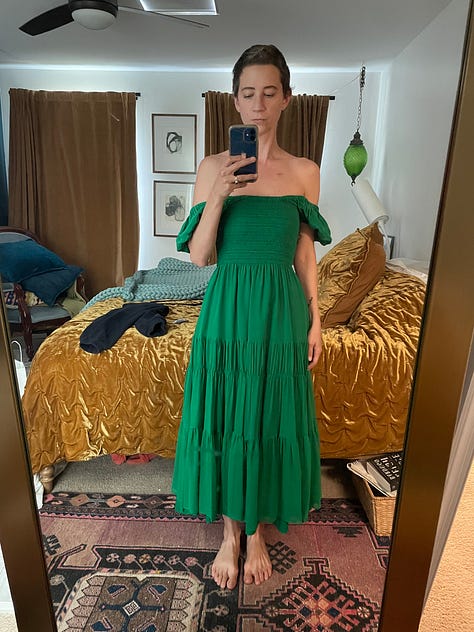
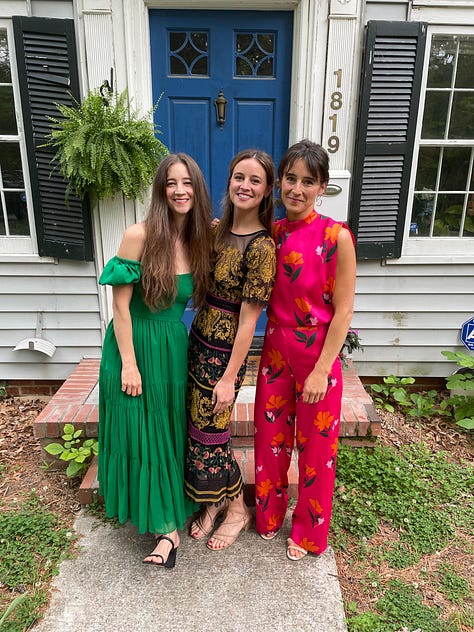
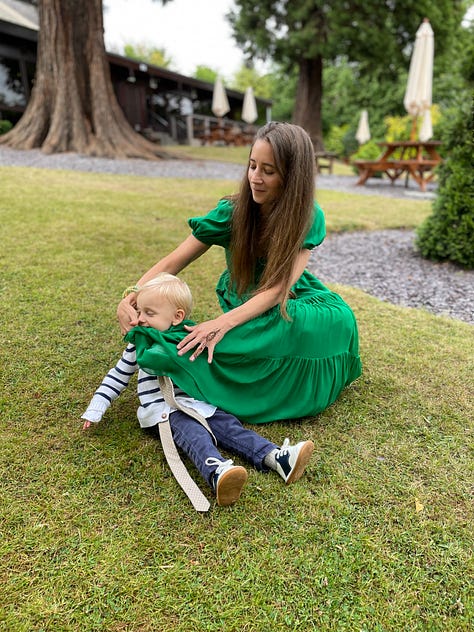
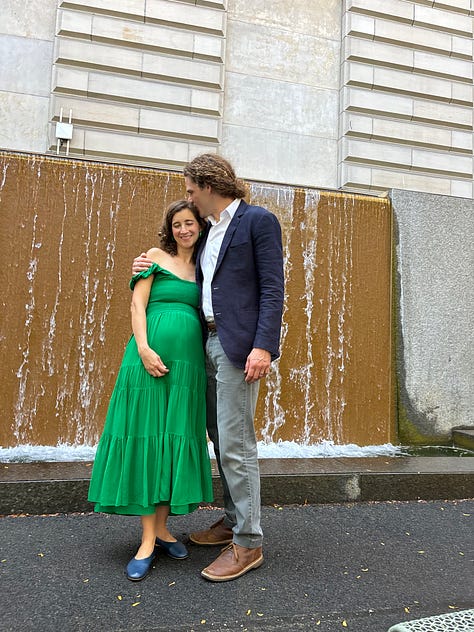
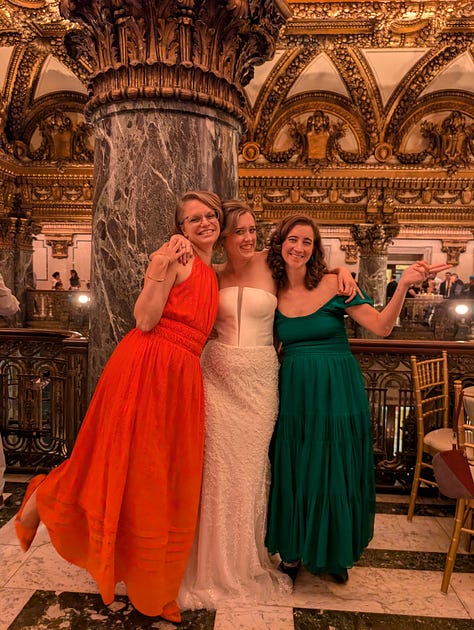
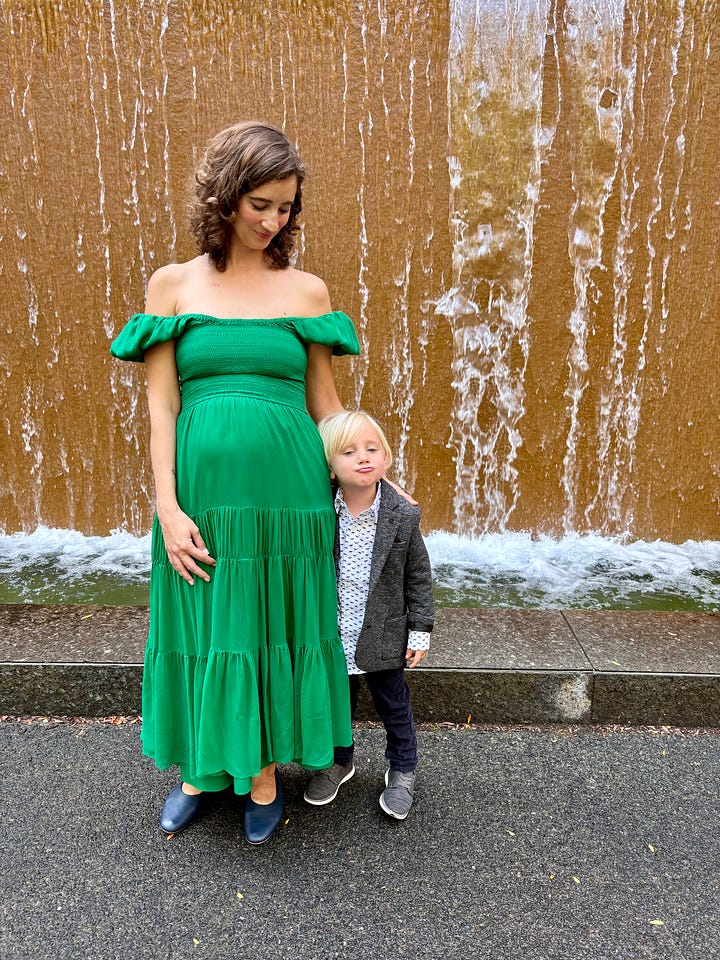

“Dad, what’s a bosom?” I asked, innocently enough, pronouncing the word BAH-SOME in the car on the way to some church event. I think I was around 10? Whew, boy. My mother and I both got in trouble for that one.
Though, h/t and rip to the old Manrepeller, I guess. Did you know I once recorded a podcast about Cohen’s crash and burn and “The Final Girlboss?”
For an amazing interview about going flat with my best friend Emily Rau, who was also diagnosed with breast cancer around the same time as me and underwent aesthetic flat reconstruction before me, check out this newsletter.




This is such a beautiful essay—I’ve read it twice now and probably will again. Thank you, Cameron! The way you describe the interiority of desire—the relationship of the self to one’s own embodied pleasure and sense of beauty is so fascinating to me. Of course, as you acknowledge, this relationship is shaped by cultural mores, but there’s something about how this interiority both engages and defies the social world that circumscribes it, in moments existing on a different plane, intimate and idiosyncratic, parallel to that world. I don’t know if my frazzled brain is making sense, but thank you again for this work.
So beautiful Cameron, the dress and this essay. I bought a jacket not long ago and I have come to think of as armour, and like you, worried about what it meant to buy something / buy into something that tread too closely to 'outside of my values' territory. But then we live in it and it just fits in so well.